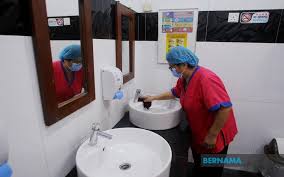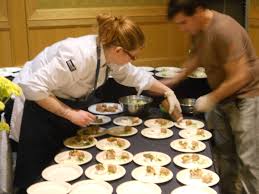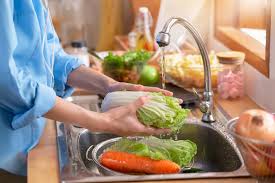Food hygiene laws affect all food businesses, including caterers, primary producers (such as farmers), manufacturers, distributors, and retailers. How the legislation affects an establishment will depend on the size and type of the business.
It is important to understand that minimum standards of hygiene are set down by law. Within these regulations required by law, every establishment will have its own way of doing things, and staff members should know what these are.
The Food Safety (General Food Hygiene) Regulations 1995
These regulations should be known and complied with by everybody involved in the handling of food.
Requirements for Proprietors of Food Premises
Proprietors of food premises are expected to operate hygienically. They must:
- Analyse food hazards;
- Decide which points are critical to food safety;
- Implement control and monitoring procedures, review periodically, and change when necessary.
Premises must:
- Be kept clean and in good repair;
- Be designed to permit good hygiene practices;
- Have adequate washbasins, toilets, and cleaning/disinfecting facilities;
- Maintain satisfactory standards of lighting and ventilation.
Additionally:
- Walls, floors, and food-contact surfaces must be easy to clean and, where necessary, to disinfect.
- Conveyance and containers used for transporting food must be kept clean and in good repair.
- Food equipment must be kept clean and in good repair.
- Food waste and refuse must not accumulate in food rooms. Adequate provision must be made for its storage and removal.
- An adequate supply of drinking water must be provided.
Food handlers must:
- Keep themselves clean;
- Wear suitable, clean, and, where appropriate, protective clothing;
- Not be allowed to work if they are likely to contaminate food.
Food, including raw materials, must be fit for human consumption, stored, and protected to minimize the risk of contamination. Food handlers must be trained and supervised in food hygiene matters.
Offenders are punishable on conviction with:
- Fines;
- In serious cases, up to 2 years in prison.
Personal Requirements
- All parts of the person liable to come into contact with food must be kept as clean as possible.
- All clothing must be kept as clean as possible.
- All cuts and abrasions must be covered with a waterproof dressing.
- Spitting is forbidden.
- Smoking is forbidden in a food room or where there is food.
- As soon as a person is aware that they are suffering from or are a carrier of infections such as typhoid, paratyphoid, dysentery, salmonella, or staphylococcal infection, they must notify their employer, who must notify the Medical Officer of Health.
Read Also: Sheep Production Guide
Requirements for Food Premises Toilets

- These must be clean, well-lighted, and ventilated.
- No food room shall contain or directly communicate with a toilet.
- A notice requesting people to wash their hands after using the toilet must be displayed in a prominent place.
- The ventilation of the soil drainage must not be in a food room.
- The water supply to a food room and toilet is only permitted through an efficient flushing cistern.
Washing Facilities
- Hand basins and an adequate supply of hot water must be provided.
- Supplies of soap and hand-drying facilities must be available by the hand basins.
Other Facilities
- First Aid: Bandages and waterproof dressings must be provided in a readily accessible position.
- Lockers: Enough storage space must be available for outdoor clothes.
- Lighting and Ventilation: Food rooms must be suitably lit and ventilated.
- Sleeping Room: Rooms in which food is prepared must not be slept in.
- Refuse: Refuse must not be allowed to accumulate in a food room. Waste bins must be lidded.
- Buildings: The structure of food rooms must be kept in good repair to enable them to be cleaned and to prevent entry of rats, mice, etc.
- Storage: Foods should not be placed in a yard lower than 0.5m (18in) unless properly protected.
Penalties
Any person guilty of an offence shall be liable to a heavy fine and/or a term of imprisonment. Under the latest Food Safety Act, unhygienic premises can be closed down by a local authority immediately, on the advice of the Environmental Health Officer.
The Environmental Health Officer, when visiting premises, will probably check for:
- Grease in ventilation ducts and on canopies;
- Long-standing dirt in less accessible areas;
- Cracked or chipped equipment;
- Provision for staff toilets and clothing;
- ‘Now wash your hands’ notice;
- Adequate and correct storage of food (cooked food stored above raw food if provision is not made for separate refrigeration);
- Correct storage temperature of foodstuffs;
- Signs of pests and how they are prevented;
- Any hazards;
- Cleaning, training records, and proper supervision.
Read Also: Fattening of Sheep and Goats Guide
Checklist for Catering Establishments

- Entrances and exits unobstructed.
- Fire doors undamaged and in operating position.
- Escape routes clearly indicated.
- Fire-fighting equipment visible and accessible.
- Good lighting.
- Suitable supply of hot and cold water.
- Good ventilation.
- Separate hand-washing basin.
- Soap, nail-brush (if provided), and towels by basin.
- Floors in good repair, clean, and dry.
- Equipment operating correctly.
- Guards on machines.
- All surfaces undamaged and clean.
- Staff trained to use machines.
- Notice concerning use of machine close to it.
- Suitable protective clothing worn.
- Food, equipment, and cleaning materials stored properly.
- Rubbish bins covered and emptied regularly.
- Staff works in accordance with safety guidelines.
Food Safety Act 1990 and Related Regulations
The Food Safety Act 1990, The Food Safety (General Food Hygiene) Regulations 1995, The Food Safety (Temperature Control) Regulations 1995, and The Food Premises (Registration) Regulations 1997 stipulate that food safety is achieved provided staff:
- Keep themselves clean;
- Keep the workplace clean;
- Wear suitable, clean clothing;
- Protect food from contamination;
- Store, prepare, serve, and display food at the correct temperature;
- Inform the manager if they have an illness;
- Do not work with food if they have food poisoning symptoms.
Compliance with the Food Safety Act 1990 ensures food safety. Food poisoning is an illness acquired from eating contaminated food, usually contaminated with bacteria, viruses, a chemical, poisonous plant, or an actual physical item.
Contamination
Bacterial and viral contamination comes from people, animals, insects, raw food, rubbish, dust, water, and the air. Chemical contamination may come from pesticides or cleaning fluids.
Physical contamination may be from dirty clothing, touching the food, or a used plaster lost from a finger.
Cross Contamination
To avoid cross contamination, the same equipment must not be used for handling raw meat and milk products without being disinfected.
To prevent the inadvertent use of equipment for raw meat and high-risk foods, it is recommended that, where possible, different colours and shapes are used to identify equipment used for different purposes as well as for different products as follows:
i. Yellow: Food preparation areas
ii. Green: Food and beverage service
iii. Blue: General purpose
iv. Red: Toilet areas
Cutting Boards and Knives:
i. White: Dairy products
ii. Grey: Bread
iii. Green: Fruit
iv. Brown: Vegetables
v. Red: Raw meat
vi. Yellow: Cooked meat
vii. Blue: Raw fish
Temperature Control
For bacteria to multiply, they need:
- Food;
- Moisture;
- Time;
- Warmth.
By removing warmth from the presence of bacteria, growth can be controlled or stopped. The temperature danger zone is between 5°C and 63°C. The ideal temperature for bacteria to multiply is the same as body temperature, 37°C.
Keeping food frozen and chilled restricts growth:
i. Freezer unit: -18°C
ii. Ice cream unit: -15°C
iii. Chilled unit: 0–5°C
Always close the refrigerator door after use. Heating food to a hot temperature kills bacteria. Ideally, the cooking temperature should be 70°C or above. Heat must penetrate all the food, and a probe should be used to ensure the temperature is hot enough.
Once food has been served, the minimum temperature for hot food must be maintained at all times. The minimum temperature is 65°C. If it does not achieve or maintain the required temperature, it should not be served.
Control of Substances Hazardous to Health
A number of cleaning substances are regarded as hazardous to health. Therefore, precautions must be taken to control their use:
- Read the label and identify the substance and its potential hazards.
- Use only the right substance for the appropriate job.
- Check if any protective clothing is required.
Good Industrial Hygiene Practice
- Do not eat, drink, or smoke when using chemicals.
- Use protective clothing as appropriate.
- Wash hands and exposed skin after using chemicals.
Practical Implications of the Temperature Control Regulations
- On receipt of deliveries, goods should be cooled to the proper temperature as soon as possible.
- To account for defrost cycle or breakdown of refrigeration, an allowance of 2°C (3°F) is permitted.
- A maximum time of two hours for cold food preparation in the kitchen is tolerated, provided there is no more than 2°C (3°F) rise above the 5°C (41°F) or 8°C (46°F) specified temperature.
- Food intended to be served hot at 63°C (115°F) or above can be held at a temperature below 63°C (115°F) but for no more than two hours.
- Exceptions are made for foods served warm (e.g., hollandaise sauce). They may be kept for no more than two hours, and any remaining must be discarded.
- Foods intended to be served cold at 5°C (41°F) or 8°C (46°F) may be held at a higher temperature but for no longer than four hours; they must then be brought back to 5°C (41°F) or 8°C (46°F).
- Displayed foods (sweet trolley, cheese board, self-service display, counter display with assisted service) need not be maintained at the required temperature, provided displayed food is kept to a minimum and does not exceed four hours.
Main Food Hygiene Regulations
The main food hygiene regulations of importance to the caterer are:
- Food Safety (General Food Hygiene) Regulations 1995
- Food Safety (Temperature Control) Regulations 1995
These implemented the European Commission (EC) Food Hygiene Directive (93/43 EEC). They replaced a number of different sets of regulations, including the Food Safety (General) Regulations 1970.
The 1995 Regulations
These regulations are similar in many respects to earlier regulations. However, as with the Health and Safety legislation, these regulations place a strong emphasis on owners and managers to identify safety risks and to design and implement appropriate systems to prevent contamination. These systems and procedures are covered by Hazard Analysis Critical Control Points (HACCPs) and/or Assured Safe Catering (ASC).
The regulations place two general requirements on the owners of food businesses:
- Ensure that all food handling operations are carried out hygienically and according to the ‘Rules of Hygiene.’
- Identify and control all potential food safety hazards, using a systems approach, either HACCP or Assured Safe Catering.
In addition, any food handler who may be suffering from or carrying a disease that could be transmitted through food must report this to the employer, who may be obliged to prevent the person concerned from handling food.
Catering establishments have a general obligation to supervise, instruct, and provide training in food hygiene commensurate with their employees’ responsibilities.
Details with regard to how much training is required are not specified in the regulations. However, Her Majesty’s Stationery Office (HMSO) Industry Guide to Catering provides guidance on training, which can be taken as a general standard to comply with the legislation.
The HMSO guide suggests three categories of food handlers, all of which need training:
- Category A: Support and front-of-house staff, including storekeeper, waiter/waitress, bar staff, counter staff, server assistant, cellar person, etc.
- Category B: Those involved in the preparation of high-risk (unwrapped) foods, including chefs, cooks, catering supervisors, kitchen assistants, and bar staff who prepare food.
- Category C: Managers or supervisors who may handle food, including all such persons based on site.
Before any food handler starts work, they must be given written and verbal instructions on the essentials of food hygiene. The second stage of training is hygiene awareness instruction.
Formal Training
Formal food hygiene training, as suggested by the industry guide, going beyond essentials and awareness, is recommended to comply with the law.
Guide to the Training of Individuals in Food Handling
| Category of Staff | Essentials of Food Hygiene | Hygiene Awareness Instruction | Formal Training Level | Formal Training Level 2 and/or 3 |
|---|---|---|---|---|
| A: Storekeeper, Waiting Staff, Bar Staff, Catering Assistants | Yes, before starting work | Yes, within 4 weeks (8 weeks for part-time staff) | No | No |
| B: Chefs, Cooks, Supervisors, Food Preparation Assistants | Yes, before starting work | Yes, within 4 weeks or 3 months for part-timers | Yes | No |
| C: Managers, Supervisors | Yes, before starting work | Yes, within 4 weeks | Yes, within 3 months | Yes, but only good practice, not essential |
The Food Safety (Temperature Control) Regulations 1995
These regulations came into force on 15 September 1995 and replaced earlier, more complex regulations. Foods that may be subject to microbiological multiplication must be held at no more than 8°C or 63°C. Exceptions include:
- Food on display, which can be displayed for up to four hours;
- Low-risk and preserved foods, which can be stored at ambient temperatures.
Manufacturers can vary upward the 8°C ceiling if there is a scientific basis to do so. Food that is to be served hot should be held at over 63°C.
This requires that any food likely to support the growth of pathogens, microorganisms, or the formation of toxins must be kept at or below 8°C. Exceptions include food that has been cooked or reheated or is for service on display for sale and needs to be kept hot.
It also applies to food where there is no health risk if it is kept at ambient temperature. Any preserved foods, including dehydrated, canned, or those with added sugar or vinegar, fall into this category, provided the containers have not been opened.
If the containers of such foods are opened, it may be necessary to store the food using temperature control. Foods that require ripening or maturing, such as cheese, may be kept outside of temperature control; however, once the process has been completed, they should then be refrigerated.
Registration of Premises
Under the Food Premises (Registration) Regulations 1991, as amended by the Food Premises (Registration) Amendment Regulations 1993, all existing food premises in England, Wales, and Scotland must register with their local authority.
Anyone starting a new food business must register 28 days before doing so. It is an offence not to be registered.
Do you have any questions, suggestions, or contributions? If so, please feel free to use the comment box below to share your thoughts. We also encourage you to kindly share this information with others who might benefit from it. Since we can’t reach everyone at once, we truly appreciate your help in spreading the word. Thank you so much for your support and for sharing!

